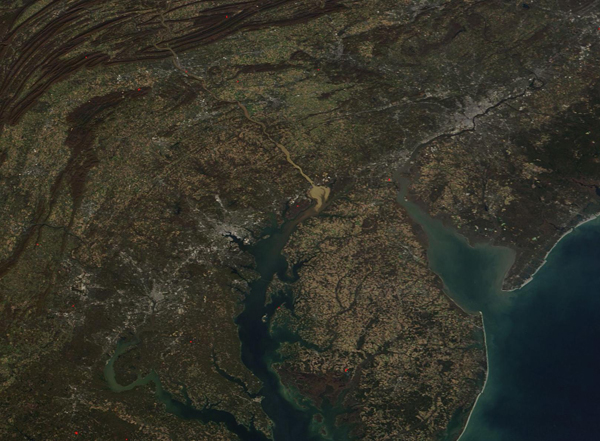Images
November 11, 2019 - Sediment flowing in to the Chesapeake Bay
Tweet
On Halloween 2019, a series of strong thunderstorms unleashed downpours and flooding in central Pennsylvania. In the days following, the rainwater runoff picked up sediment from farmland in the region and carried it into the Susquehanna River, past the Conowingo Dam, and into the Upper Chesapeake Bay. On November 6, 2019, the Moderate Resolution Imaging Spectroradiometer (MODIS) on NASA’s Terra satellite acquired this true-color image of the sediment-rich river water flowing into the Bay.
Not far from where the Susquehanna River enters the Bay, the waters wash over an expanse of underwater grasses on the Susquehanna Flats. The flats are prime habitat for birds, fish, and crabs, and the health of the grasses is an indicator of water quality in that part of Chesapeake Bay.
Big influxes of sediment can pose a risk to underwater grasses because when water gets too cloudy, grasses don’t always get enough sunlight. Though unusually wet weather has recently raised concerns that runoff might harm the Bay’s underwater vegetation, an annual survey released by a team of Virginia Institute of Marine Science researchers in July 2019 found that the grasses had weathered the big sediment loads pretty well.
Image Facts
Satellite:
Terra
Date Acquired: 11/6/2019
Resolutions:
1km (126.2 KB), 500m (338.7 KB), 250m (265.1 KB)
Bands Used: 1,4,3
Image Credit:
MODIS Land Rapid Response Team, NASA GSFC
Tweet
On Halloween 2019, a series of strong thunderstorms unleashed downpours and flooding in central Pennsylvania. In the days following, the rainwater runoff picked up sediment from farmland in the region and carried it into the Susquehanna River, past the Conowingo Dam, and into the Upper Chesapeake Bay. On November 6, 2019, the Moderate Resolution Imaging Spectroradiometer (MODIS) on NASA’s Terra satellite acquired this true-color image of the sediment-rich river water flowing into the Bay.
Not far from where the Susquehanna River enters the Bay, the waters wash over an expanse of underwater grasses on the Susquehanna Flats. The flats are prime habitat for birds, fish, and crabs, and the health of the grasses is an indicator of water quality in that part of Chesapeake Bay.
Big influxes of sediment can pose a risk to underwater grasses because when water gets too cloudy, grasses don’t always get enough sunlight. Though unusually wet weather has recently raised concerns that runoff might harm the Bay’s underwater vegetation, an annual survey released by a team of Virginia Institute of Marine Science researchers in July 2019 found that the grasses had weathered the big sediment loads pretty well.
Image Facts
Satellite:
Terra
Date Acquired: 11/6/2019
Resolutions:
1km (126.2 KB), 500m (338.7 KB), 250m (265.1 KB)
Bands Used: 1,4,3
Image Credit:
MODIS Land Rapid Response Team, NASA GSFC




